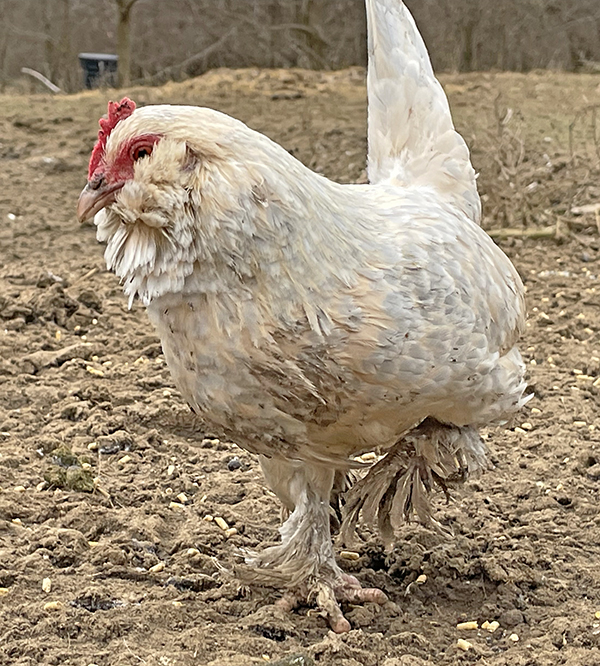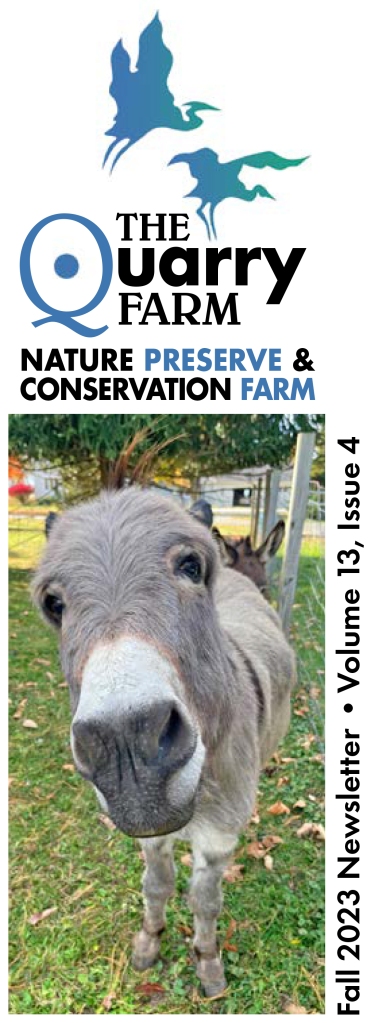In one county to the east, toads and spring peepers sing in wetlands, warmed in the urban heat island. They are quiet here on The Quarry Farm. There is no hint of green as you look over the lowland treetops. Spring wildflowers have better sense than Golden-crowned Kinglet that conceal themselves as much as possible in bare treetops, calling their thin, high-pitched call to anyone that arrived a tad too early.

It was chilly enough for coats for the March 2 hike. We followed White-tailed Deer, Eastern Fox and Gray Squirrel and Wild Turkey tracks in the nature preserve. A Great Blue Heron left a nearly complete fish skeleton for us to find on the south bank of the quarry wetland. The birds were quiet, for the most part. Two days later, I counted 16 avian species in the short walk between the farm animal sanctuary and the pavilion. The temperature hit 74 degrees F. This weather is crazy. Today, the toads, salamanders and spring peepers remain burrowed deep under the quarry and oxbow water and forest floor leaf matter in anticipation of a weekend of rain and wet snow.
As the weather changes its mind, the wild and domestic animals here do not change theirs. Two weeks ago, our beloved, elderly Sophie, the best porcine educational ambassador ever, died. As always, the animals gathered around the grave until the ground was smoothed over. Donkeys Lucy and Silky had to be whispered to and hugged. Everyone slowly wandered away. Two weeks later, everyone is love-struck and besotted; infatuated and obsessed. Spring will be here officially on March 21. Spring twitterpation is now. The fostered re-wilding Canada Geese call to the wild ones on Cranberry Run. The goats bark and huff, bumping foreheads across the paddock. Patches, Pockets, Gerald, Mr. Fabulous, Caramel, Sydney and Chicken Ricky crow their rooster hearts out when American Woodcocks hurtle through the evening sky. Tom turkeys Edgar and Bernard strut their impressive stuff while turkey hen Souix does her best to avoid them. There is whole lot of “Get off my lawn!” happening this season.

During Winter’s coldest, the chickens warm their feet by riding around on the donkeys, pigs, and goats. I’m sure the feathered spot of warmth is soothing on the mammals’ backs. In the midst of Spring chest-thumping and display, two individuals share a daily lesson of tolerance and respect. Tom Turkey Bruce has always been unsteady on his feet. he came here a few years ago after being dumped in a park. He was found spinning in circles, unable to walk more than a few steps due to probable fattening in close confinement. Canada Goose “K” (named for the tag around his left ankle) prefers the company of Bruce to the rest of the Canada geese. K keeps an eye on Bruce, making sure the two are never far apart. In the evening, K will match steps with Bruce as he makes he slow way into the barn. On Monday, Steve watched the two approach the door. Bruce waivered when he got to the steps. As he turned away from the enclosure, K reached out and gently prodded Bruce into the building before hopping in behind him.
Tim Jasinski, Wildlife Rehabilitation Specialist for the Lake Erie Nature and Science Center, was interviewed recently for the podcast Wildlife Rehabilitation: From Rescue to Release. His focus was on Canada geese. Among other things, he talked about some of their behaviors that often make them a target of human aggression. Rather than try to understand the reason for why Canada geese do what they do, we drive them away or worse. But if a stranger walks up to your child and picks them up, wouldn’t you fight bill and flapping wing to stop them?
Three weeks from now, 31.6 percent of the global human population will celebrate a man who made the ultimate sacrifice for all. We observe the time leading up to the observance by meditating on written word, coloring eggs and eating fish on Fridays, all the while arguing—warring—about who should be even our most distant neighbor. What if we share the fish, and not just on Fridays?




























